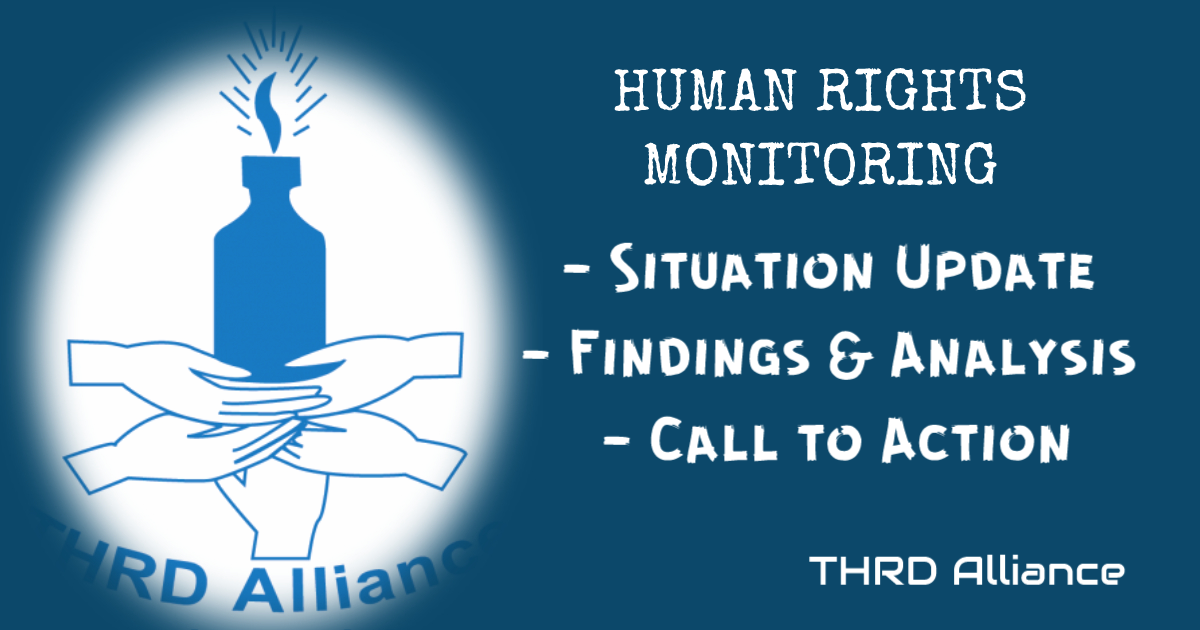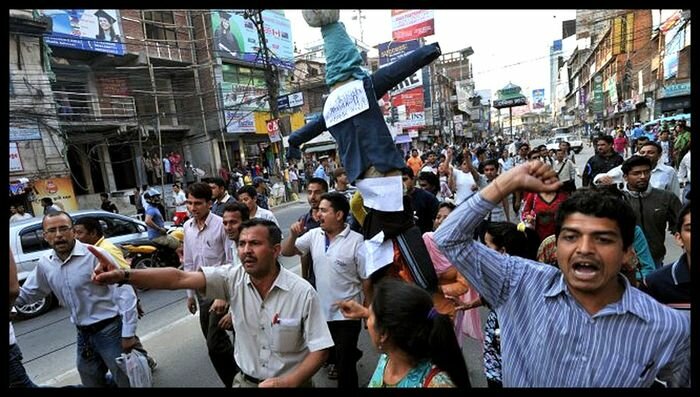The Government of Nepal on March 24 announced nationwide lockdown to control the spread of COVID- 19 pandemic and ended the lockdown on July 21.
Although, the lockdown was finally lifted almost after four months, the government continued restrictions and prohibitions on various businesses and services as well as people’s movement to contain the spread of coronavirus in the country.
Daily wagers, factory workers and self-employed people failed to earn their livelihood during the four-month long lockdown. After the lockdown was ended, restrictions and prohibitory orders were also issued in some parts of the country to prevent the spread of COVID-19. Therefore, most of people were unable to work due to the restrictions, which were lifted from September 11.
A study conducted by Nepal Rastra Bank, (Nepal’s Central Bank) in June, 2020, showed that Nepali businesses laid off 22.5% of their workers during lockdown and the most of these layoffs happened in hotels and restaurants followed by agriculture, forestry, fisheries and the wholesale and retail sectors.[1]
As per a study on COVID-19 labour market impact in Nepal conducted by International Labour Organization (May 21, 2020), approximately 5.7 million or 80.8 per cent of workers in Nepal have informal jobs. The majority of workers in all sectors are in informal employment, including the sectors expected to face the highest degree of disruption: construction (97 per cent), trade (74 per cent) and manufacturing (84 per cent) during the lockdown. According to the study, informal workers lack the basic benefits usually provided by a formal job, including social protection coverage.[2]
A study on “Rapid Assessment of the Social and Economic Impacts of COVID-19 on the vulnerable groups in Nepal” – commissioned by the UN Development Programme in Nepal and conducted by the Institute for Integrated Development Studies (As per May 26, 2020), three in five employees lost their jobs due to COVID-19 in Nepal.[3]
Most of workers of informal sectors are from marginalized and Dallit communities (International Labour Office, Nepal, 2005). And they suffered the most during the lockdown and restrictions.[4]
The government announced that it would provide relief packages to the vulnerable groups–, daily wagers, workers of informal sectors and poor people through local bodies, however, it failed to provide such relief packages to the needy people. Gap in government’s pledge and delivery costed many lives.
As they were forced to stop their work either due to lockdown, prohibitory orders, closure of business, due to illness or for being quarantined, they did not get required supports from the state authority.
During the coronavirus pandemic, more Dallits have become the victims of human rights violations. As per the data and monitoring of THRDA, at least 19 Dallits, including 13 in Terai/Madhes, were attacked and killed in various incidents during the coronavirus pandemic. They suffered sexual assaults and violence as well.
Rape and murder :
Media reported that 1,221 rape cases were reported since March 14, 2020. At least 134 rape incidents were reported during mid-March to mid-April, 152 cases during mid-April to mid-May, 196 incidents during mid-May to mid-June, 240 during mid-June to mid-July, 266 cases during mid-July to mid-August and 233 incidents during mid-August to mid-September.[5]
As per the data of Women’s Rehabilitation Centre (WOREC), at least 48 rape incidents were recorded between March 24 and May 15, 2020,[6] while another data of the organization showed that at least 112 rape cases were recorded during mid-July to mid-August, 2020.[7]
Similarly, another data from media (September 13, 2020) showed that at least 77 rape incidents were reported in Province-2 alone in last two months and majority of the cases were from Dallit community.[8]
During the lockdown, Dallit girls were raped or in some cases they were murdered after rape. As per the monitoring and documentation of THRDA, a 12-year-old Dallit girl from Rupandehi district was raped and later she was found murdered on May 23, 2020, while a 17-year-old Dallit girl from Saptari district was allegedly gang-raped on September 14. She took her own life after she was prevented to seek legal remedies by the local Panchayat.[9] Similarly, a 17- year old from Dhanusha district was found dead after rape on September 3. On September 23, 2020, a 12-year-old Dallit girl from Bajhang district was allegedly raped and murdered.[10]
Custodial deaths extrajudicial killings :
During the lockdown and prohibitory period, at least four cases of custodial deaths and four cases of extrajudicial killings were recorded and among them three Dallits died in the custody were monitored and documented by THRDA. Sambhu Sada, Bijay Mahara and Roshan BK died in police custody during the lockdown. Two cases of EJK were related to Muslim community.
In the incidents of custodial deaths or extrajudicial killings, the state authorities have always denied ensuring justice to victims. Similarly, various probe committees were formed to investigate the incidents but reports were never made public and culprits were never punished.
Lack of relief materials :
The Government of Nepal provided relief materials to the daily wage earners, workers of informal sectors, poor and vulnerable groups but due to lack of identity documents most of the people, mostly poor Dallits and marginalized communities failed to get relief materials provided by the state. On the other hand, the relief materials, which were meant to be distributed, found to be rotten in store rooms.[11] Similarly, local elected representatives favoured their relatives and to those who voted in their favour while distributing the relief materials, while there were reports that the local bodies provided less quantity of packages.[12]
As a result, some of the poor Dallits and people marginalized communities died due to starvation or took their own life. As per the data of THRDA, Malara Sada from Saptari died due to starvation, while Dilmaya Darji from Morang, Satan Majhi from Parsa among others died by suicide.[13]
Various organizations and individuals came to distribute relief materials to the poor, daily wagers and vulnerable communities along with Dallits but only after tragic incidents happened.
Ironically, state authorities also banned individuals and private organizations from distributing relief materials in the name of preventing publicity.[14]
Deaths due to lack of medical access :
Since the coronavirus pandemic hit the country and lockdown was imposed, access to medical facilities was also denied to the vulnerable and poor people by the state. Due to lack of timely medical facilities, people from Dallit communities once against suffered the most.
As per the monitoring of THRDA, Raju Sada from Dhanusha, Bimala Rishidev from Morang, Rukmini Sada from Mahottari and Sabita Mukhiya from Sarlahi due to lack of timely medical treatment during the COVID-19 pandemic period.
Response of Province-2 :
As per the data of Province-2, Dallit population in the province is 17.27% but they hold very low socio-economic status in Human Development Index. Similarly, they lack access to medical, educational, job facilities among others due to citizenship and other documents. Majority of them are landless. On the other hand, various data show that there have been continued human rights violations against the community. Irony is that justice is rarely ensured for them.
During the lockdown, at least six Dallits were attacked or kidnapped and killed, while two Dallits girls died after being raped, two Dallit youths died in custody and two Dallit person died due to lack of medical treatments and a one Dallit person died due to starvation.
Province-2 Government provided financial support to the family of Raju Sada and Sambhu Sada, It has announced financial support for the families of Bijay Mahara and Malara Sada.
Since state and the civil society were weak in ensuring legal investigation or justice, the struggle of Dallit Struggle Committee and Dallit communities forced the state authorities to form probe committees to investigate the deaths of Sambhu Sada and Bijay Mahara.
On September 2, 2020, meeting of the Racial Discrimination and Untouchability Monitoring Committee formed under the Dalit Empowerment Act by the Province-2 Government decided to investigate killings of Niranjan Ram, Bijay Mahara (Ram), Mitra Devi Baidha and Shreeram Sah. To investigate the killings, a five-member committee, led by Minister for Internal Affairs and Law Gyanendra Yadav, formed and was given 15-days of time to submit its report.
Likewise, Provincial government also formed probe committee to investigate the custodial deaths and death due to lack of medical treatments as well as initiated for the legal process. However, victims of custodial deaths or those who died due to lack of timely medical treatments are yet to get justice from the state.
Similarly, investigation reports, either of provincial government or federal government, have not been made public yet which also cause delay in providing justice to the victim and punishing the perpetrators under legal procedures.
On September 17, 2020, the Law, Justice and Human Rights Committee (LJHRC) of the House of Representatives formed a sub-committee to study the recent deaths in police custodies in the country.[15] And the committee is yet to complete their work.
On the other hand, National Human Rights Commission of Nepal issued a press statement on August 28 asked the government to bring those involved in the human rights violations and attacks against Dallits into the legal procedures.[16]
Article 16 of the Constitution of Nepal (2015) has ensured right to live with dignity, Article 18 has ensured right to equality, Article 24 has ensured right against untouchability and discrimination and Article 40 has ensured rights of Dalits. However, the recent incidents have violated the rights ensured in the constitution.
Call to Action :
Due to poor social and economic status, Dallits are always in vulnerable conditions but the COVID-19 pandemic made them more vulnerable. Similarly, various forms of human rights violations continued against them during the COVID-19 pandemic but the justice was not ensured by the state.
So, THRDA recommends that:
- The Government of Nepal (GoN) should come up with the Relief Programme for the Dallits and vulnerable communities so that they should not have to worry about managing two meals a day,
- The GoN should introduce Employment Programmme for Dallits and marginalized unemployed people so that they could generate regular income,
- The GoN should ensure free and effective treatments to Dallits and other marginalized people in hospitals, and
- The GoN should mandatorily conduct fair investigation in the incidents of human rights violations against the Dallits and other communities, ensure that legal actions should be taken against the culprits and provide adequate compensation to the victims.
Please find the PDF copy here.
References:
[1]https://myrepublica.nagariknetwork.com/news/nearly-a-quarter-of-nepal-s-workers-lose-jobs-due-to-coronavirus-central-bank/
[2]https://www.ilo.org/kathmandu/whatwedo/publications/WCMS_745439/lang–en/index.htm
[3]https://www.np.undp.org/content/nepal/en/home/presscenter/articles/2020/Three-in-Five-employees-lost-their-jobs-due-to-COVID19-in-Nepal.html
[4] https://www.kios.fi/en/2020/06/dalits-in-nepal-amid-lockdown/
[5] https://ekantipur.com/news/2020/09/30/160142732511872966.html
[6]https://www.worecnepal.org/content/131/2020-05-20
[7]https://www.worecnepal.org/content/167/2020-09-13
[8] https://www.hulakinews.com/
[9]https://pahilopost.com/content/20200916072327.html
[10] https://www.recordnepal.com/wire/features/the-bajhang-rape-and-murder-case/
[11]https://ekantipur.com/pradesh-1/2020/05/16/15896157103206122.html
[12]https://ratopati.com/story/126921/2020/4/20/rahat
[13]https://www.nayapatrikadaily.com/news-details/51381/2020-09-18?fbclid=IwAR2NgjpNsq1xxUTD5JMu4hbFRxaorq0zbR2TwWI_W7zfPB-rhLkCbcbMQz0
[14]https://kathmandupost.com/province-no-5/2020/04/10/dang-bans-distribution-individuals-and-organisations-from-distributing-relief-on-their-own
[15] https://www.onlinekhabar.com/2020/09/897075?utm_source=Facebook&utm_medium=FBpage1
[16] https://www.nhrcnepal.org/nhrc_new/doc/newsletter/NHRC%20Nepal%20Press%20Release-2077-5-12.pdf?fbclid=IwAR39uMyWwJM7ovjgmGt2_p9_mCNCRVeNb6I-8zNIuOzg0B7_gj75kUY_3Jo




